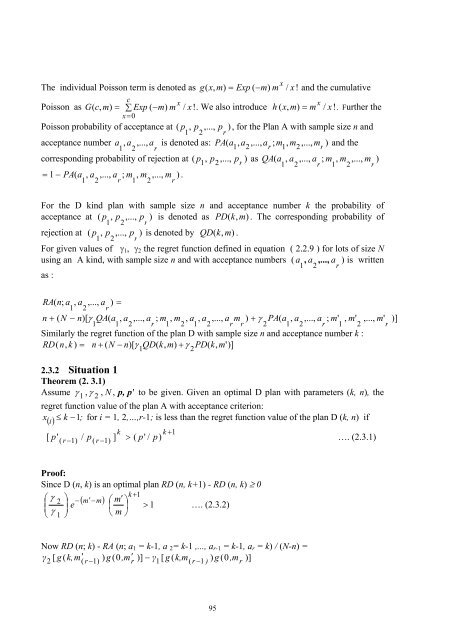Multiattribute acceptance sampling plans - Library(ISI Kolkata ...
Multiattribute acceptance sampling plans - Library(ISI Kolkata ...
Multiattribute acceptance sampling plans - Library(ISI Kolkata ...
Create successful ePaper yourself
Turn your PDF publications into a flip-book with our unique Google optimized e-Paper software.
The individual Poisson term is denoted as g( x,<br />
m)<br />
= Exp ( −m)<br />
m / x!<br />
and the cumulative<br />
c<br />
x<br />
x<br />
Poisson as G( c,<br />
m)<br />
= ∑ Exp ( −m)<br />
m / x!<br />
. We also introduce h ( x,<br />
m)<br />
= m / x!<br />
. Further the<br />
x=<br />
0<br />
Poisson probability of <strong>acceptance</strong> at ( p , p ,..., p ) , for the Plan A with sample size n and<br />
1 2 r<br />
<strong>acceptance</strong> number a , a ,..., a is denoted as: PA , ,..., ; , ,..., )<br />
1 2 r<br />
( a1 a2<br />
ar<br />
m1<br />
m<br />
2 mr<br />
and the<br />
corresponding probability of rejection at ( p<br />
1,<br />
p2,...,<br />
pr<br />
) as QA(<br />
a , a ,..., a ; m , m ,..., m )<br />
1 2 r 1 2 r<br />
= 1 − PA(<br />
a , a ,..., a ; m , m ,..., m ) .<br />
1 2 r 1 2 r<br />
x<br />
For the D kind plan with sample size n and <strong>acceptance</strong> number k the probability of<br />
<strong>acceptance</strong> at ( p , p ,..., p ) is denoted as PD ( k,<br />
m)<br />
. The corresponding probability of<br />
1 2 r<br />
rejection at ( p , p ,..., p ) is denoted by QD ( k,<br />
m)<br />
.<br />
1 2 r<br />
For given values of γ 1 , γ 2 the regret function defined in equation ( 2.2.9 ) for lots of size N<br />
using an A kind, with sample size n and with <strong>acceptance</strong> numbers ( a , a ,..., a ) is written<br />
as :<br />
1<br />
2<br />
r<br />
RA(<br />
n;<br />
a<br />
, a<br />
,..., a<br />
1 2 r<br />
) =<br />
n + ( N − n)[<br />
γ QA(<br />
a , a ,..., a ; m , m , a , a ,..., a m ) + γ PA(<br />
a<br />
, a<br />
,..., a<br />
; m'<br />
, m'<br />
,..., m'<br />
1 1 2 r 1 2 1 2 r r 2 1 2 r 1 2 r<br />
Similarly the regret function of the plan D with sample size n and <strong>acceptance</strong> number k :<br />
RD ( n,<br />
k ) = n + N − n)[<br />
γ QD(<br />
k,<br />
m)<br />
+ γ PD(<br />
k,<br />
')]<br />
(<br />
1 2<br />
m<br />
)]<br />
2.3.2 Situation 1<br />
Theorem (2. 3.1)<br />
Assume γ<br />
1<br />
, γ<br />
2<br />
, N , p, p'<br />
to be given. Given an optimal D plan with parameters (k, n), the<br />
regret function value of the plan A with <strong>acceptance</strong> criterion:<br />
x() i<br />
≤ k −1;<br />
for i = 1, 2,…,r-1; is less than the regret function value of the plan D (k, n) if<br />
k<br />
k + 1<br />
[ p '( r − 1) / p(<br />
r −1)<br />
] > ( p'<br />
/ p)<br />
…. (2.3.1)<br />
Proof:<br />
Since D (n, k) is an optimal plan RD (n, k+1) - RD (n, k) ≥ 0<br />
⎛ γ<br />
k + 1<br />
⎞<br />
⎜ 2 ⎟<br />
− ( m′−m)<br />
⎛ m′<br />
⎞<br />
e ⎜ ⎟ > 1 …. (2.3.2)<br />
⎝ γ<br />
1 ⎠ ⎝ m ⎠<br />
Now RD (n; k) - RA (n; a 1 = k-1, a 2 = k-1 ,..., a r-1 = k-1, a r = k) / (N-n) =<br />
γ2 [ g ( k,m′<br />
( r 1)<br />
) g (0,m′<br />
r<br />
)] − γ1<br />
[ g ( k,m(<br />
r 1 )<br />
) g (0,mr<br />
)]<br />
−<br />
−<br />
95
















